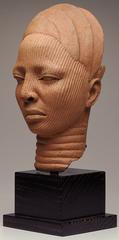
 This shrine head was created during a period of artistic and cultural development from the twelfth to the fourteenth century in the Yoruba kingdom of Ife, an area that is now part of southwestern Nigeria in Africa. According to the traditional Yoruba creation story, life and civilization began for the Yoruba people in the ancient city of Ile-Ife. In one version of the story, the god Oduduwa descended from the heavens on an iron chain holding a chicken and a gourd filled with dirt. He threw the dirt upon the waters that covered the earth and then placed the chicken upon it. The chicken scattered the dirt around and created the first dry land. Oduduwa stood on the land, called Ile-Ife ("Home-Spread"), and became its first priest and ruler, or ONI. Ife remained the Yoruba religious and political center until the fifteenth century.
This shrine head was created during a period of artistic and cultural development from the twelfth to the fourteenth century in the Yoruba kingdom of Ife, an area that is now part of southwestern Nigeria in Africa. According to the traditional Yoruba creation story, life and civilization began for the Yoruba people in the ancient city of Ile-Ife. In one version of the story, the god Oduduwa descended from the heavens on an iron chain holding a chicken and a gourd filled with dirt. He threw the dirt upon the waters that covered the earth and then placed the chicken upon it. The chicken scattered the dirt around and created the first dry land. Oduduwa stood on the land, called Ile-Ife ("Home-Spread"), and became its first priest and ruler, or ONI. Ife remained the Yoruba religious and political center until the fifteenth century.
 As
the Yoruba people grew in number, densely populated cities surrounded
by agricultural lands became characteristic of Yoruba civilization. City
walls and gates and a protected, settled population fostered the development
of terra-cotta sculpture and other crafts that expressed the prosperity
and importance of Ife. From life-size figures to very small figurines,
Ife terra-cottas took the form of freestanding heads, animals, figure-shaped
vessels, and many other subjects.
As
the Yoruba people grew in number, densely populated cities surrounded
by agricultural lands became characteristic of Yoruba civilization. City
walls and gates and a protected, settled population fostered the development
of terra-cotta sculpture and other crafts that expressed the prosperity
and importance of Ife. From life-size figures to very small figurines,
Ife terra-cottas took the form of freestanding heads, animals, figure-shaped
vessels, and many other subjects.
The Yoruba people still settle in populous urban centers, with various family groups living in areas surrounding the compound of a chief or the palace of a king. Local artists continue to create works of art to celebrate the gods and serve the court.

Key ideas.
Where does it come from?
What does it look like?
How was it used?
How was it made?
How big is it?
Who Knows?
Additional resources.
